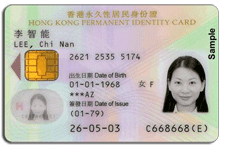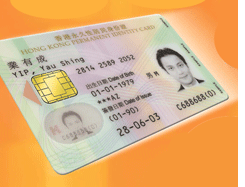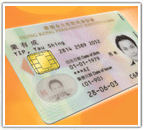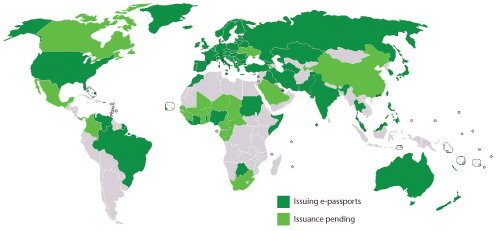Hong Kong’s mandatory citizen smart card expedites travel, secures financial transactions
08 December, 2006
category: Biometrics, Library
 By Andy Williams, Contributing Editor
By Andy Williams, Contributing Editor
Even though the Hong Kong ‘territory-wide’ Smart Identity Card project went live three years ago and even though it is issuing some 8,000 cards a day, it’s still going to take until April next year for every eligible citizen to receive the upgraded smart cards.
About five million smart cards have been issued so far to citizens 11 and above, out of a population of nearly seven million, according to Pieter Hoogendoorn, business manager for ACI (Applied Communications, Inc.) Worldwide, a UK company that provides card management solutions the program.
In 2000, the Immigration Department of the Government of the Hong Kong (ImmD) first formulated an ambitious plan to provide every citizen with a smart identity card. The new smart card was developed to verify identity but also to provide the infrastructure that would eventually be expanded to include other e-government services on the card, said Mr. Hoogendoorn. Its implementation also allowed the ImmD to efficiently deal with some 200 million travelers the city sees each year.
“Hong Kong has a long history of national ID cards,” he said. The first, a paper card, was issued in 1949. “Since there is so much international traffic going in and out of Hong Kong, the government was looking to upgrade its existing national ID card which was becoming error-prone and subject to fraud (and they) wanted to provide a card to citizens to accelerate border traffic,” he added. “If you have a national ID card, you can cross the border in 15 seconds.”
Once the ImmD decided to move forward, it brought in systems integrator Pacific Century CyberWorks Limited (PCCW), the city’s largest telecommunications company. ACI was contracted to manage the program, specifically the card’s life cycle. Within 15 months ACI and PCCW began delivering the card and application management system to Hong Kong’s citizens.

What is life cycle management?
“Each ID card being issued has a record that’s maintained in a central database,” Mr. Hoogendoorn explains. “We manage the card’s life cycle up until it’s deleted from that database (and) provide the capability to add applications to the card post-issuance.”
ACI’s Chip Manager, the solution used by the Hong Kong ID program, is a suite of software products that enables issuance and life cycle management of smart cards. “We use the term smart card in a generic way,” stresses Mr. Hoogendoorn. “The same system that manages smart cards can also manage biometric passports … The form factor is irrelevant.”
The system, he said, provides “functionality to enable you to enroll a person who applies for a card, register names, and breeder documents. It’s a functionality that can be loaded into the chip and includes cryptographic material allowing you to send information to machines, such as computers. We have functionality that manages raw material during the production process, and post issuance can update it by adding new applications to a card or to change an application parameter that sits on the card, for example conditions of stay, or length of stay,” he added.
Suite of applications integrate card into daily life
“The card has a 64K chip with the person’s name printed on it … a digital image as well as two fingerprints from each hand,” said Mr. Hoogendoorn. The card runs the Multos operating system, is manufactured by Swiss smart card producer Trueb AG, and uses chips from Infineon and others.
“It currently contains three applications: the person’s identity, a library card, and, if the person wants, a digital certificate, known as e-Cert, that can be used for financial transactions,” adds Mr. Hoogendoorn.
The e-Cert is an opt-out process. It is included unless the citizen specifically requests that it not be. In addition to financial transaction security, the e-Cert can be used to digitally sign documents.
Once the card is issued, the citizen can visit one of 27 kiosks around the city to update the digital certificate. This is done after the card is inserted and the person applies the correct fingers to the fingerprint reader, said Mr. Hoogendoorn.
“There is space (on the card) for more applications. The government is thinking of adding driver licenses in 2007,” he said.
Next year, the government also intends to begin issuing biometric passports. “We’ve been selected to provide the management system. It will be an extension of the national ID card,” said Mr. Hoogendoorn.
 Speed at issuance and speed at usage points …
Speed at issuance and speed at usage points …
One of the major advantages of the new system is its speed. After the registration, the identity cards are issued in 10 working days as compared to 15 working days in the past. The more efficient card production system spits out 8,000 cards daily as compared with a previous output of just 2,000 cards a day. It’s also now a one-stop service that takes 15 to 30 minutes to complete, instead of the hour that it used to take, he said.
The immigration clearance processing time for residents and visitors has also been substantially shortened to less than 15 seconds and 60 seconds respectively under normal circumstances. In terms of passenger waiting time, in 2004, the immigration checkpoint at Hong Kong International Airport was able to clear more than 99% of the 66,000 daily passengers within 15 minutes, well exceeding the performance pledge of 92%, according to ACI. For other land and harbor checkpoints, they were able to clear 99% of the 490,000 daily passengers within 30 minutes.
Using this card, border crossings to and from mainland China have also been speeded up significantly.
What’s next for the Hong Kong ID?
While the card can be updated at one of the government-run kiosks, the next step is for the Hong Kong citizen to be able to attach a reader to his computer at home. “That hasn’t been implemented yet,” said Catherine Rawcliffe, ACI’s head of electronic identification. “We just have to make sure the security is in place. It’s up to the government to determine whether to allow this from home.”
Mr. Hoogendoorn admits the trend is towards contactless. Witness the city’s Octopus transit card. “But at the time, Hong Kong decided to go with this card because contactless wasn’t stable enough to provide what they needed,” he said. If the decision were made today, it would probably lean towards contactless. But to do so now, with the current system already in place, the infrastructure would have to be upgraded.




